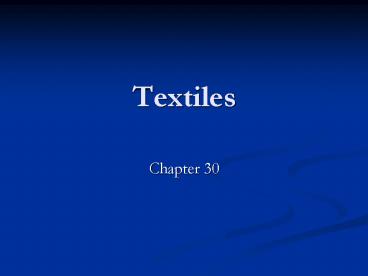Textiles - PowerPoint PPT Presentation
1 / 12
Title:
Textiles
Description:
No, because the elastomeric yarn is made in Peru (answer is E) Title: Carnets CFR 114 Author: Tom O'Leary Last modified by: toleary Created Date: 9/1/2003 4:13:16 AM – PowerPoint PPT presentation
Number of Views:116
Avg rating:3.0/5.0
Title: Textiles
1
Textiles
- Chapter 30
2
What is a Textile Product
- A Textile or Apparel product is any good
classified in HTS 50 63 and the list in
102.21(b)(5). - See the list now!!!
- Keep this section open for this lecture
3
Textile Vocabulary
- De Minimis allows a textile or apparel good to
contain a small percent by weight of foreign
fibers or yarns. Usually 7. - Elastomeric Yarn Like a spandex type yarn. A
textile or apparel good containing elastomeric
yarns in the component that determines
classification of the good is eligible for
preferential treatment if the elastomeric yarn is
wholly formed in the territory of a party to the
agreement. (In short, normally the elastomeric
yarn must be made in the country of the trade
program)
4
Textile Vocabulary Cont.
- TPL Temporary Preference Level. Similar to a
tariff rate quota. A certain quantity of goods
can enter during an annual period and receive a
reduced rate or duty free treatment even though
they do not meet tariff shift rules. - QIZ Qualified Industrial Zone. Jordan and
Egypt have a QIZ.
5
Textile Vocabulary Cont.
- Visible Lining Rule Certain fabrics which are
used as a visible lining material in coats,
anoraks, suits, jackets, skirts, and similar
articles, must be formed and finished in the
Country of the trade program to claim
preferential treatment. The rule applies to the
visible lining fabric in the main body of the
garment, excluding sleeves, and does not apply to
removable linings.
6
Textiles Rules of Origin 102.21
- Where the fabric is woven, knitted, needled, or
created (Ex. A roll of fabric) - Articles such as blankets, linens, labels,
curtains, and scarves, Country of Origin is where
the fabric was created not where product is
finished - The Country of Origin for most yarn is where the
staple fibers are spun into a yarn.
7
Textile Rules Continued
- 1. Where good is wholly obtained or produced
- 2. Where the foreign material undergoes tariff
shift 102.21e (see example on next slide) - 3. Where good is knit to shape (def. .21(b)(3))
- 4. Where good was wholly assembled
- 5. Where the most important assembly process
occurred - 6. Where an important assembly process occurred
8
Textiles Rules of Origin 102.21
- Tariff Shift - the country of origin of a textile
or apparel product may be determined by a shift
(manufacturing process) from one Harmonized
Tariff (HTS) Number to another - as listed in the
tariff shift rules. - Example classification for headings 5204
through 5207 (cotton yarns) states that these
products can be from any other heading provided
that the change or shift results from a spinning
process. So, cotton yarns will be considered
country of origin X if cotton yarns are formed
from a spinning process in country X.
9
Textile Marking
- 1. Country of Origin, 2. fiber content, 3. care
instructions, 4. manufacturer or importer. - The Federal Trade Commission (FTC) allows
registration of the manufacturer or importer
names. When a manufacturer registers with the
FTC, they receive an RN code, which can be used
in place of manufacturer name.
10
Redelivery
- Any textile that is entered is considered a
conditional release for 180 days from the date of
release for determination of Country of Origin.
141.113(b) - CBP can demand redelivery for up to 180 days from
date of release if country of origin was
misrepresented to CBP.
11
Misc.
- Quota categories
- 200 series -cotton and/or man made fiber
- 300 series -cotton (likely when item is 50 or
more by weight) - 400 series -wool (likely when item is 17 or more
by weight) - 600 series -man made fiber (likely when item is
50 or more by weight) - 800 series -silk blends or non cotton vegetable
fibers - Textile Trade Programs
12
- Would a garment classifiable in Chapter 62 and
shipped to the U.S. - qualify for treatment under the U.S. - Australia
Free Trade - Agreement (UAFTA) if it is manufactured in
Australia of Australian - silk (94), elastomeric yarn made in Peru (3)
and cotton lace - made in Ethiopia (3)?
- A. Yes, because the chief weight of the fabric is
made in the territory of a UAFTA party - B. No, because the cotton lace trimming is not
made in the territory of a UAFTA party - C. Yes, because the de minimus rule states an
originating textile or apparel good may contain
7 by weight of foreign fibers or yarns - D. No, because the fact that the cotton lace is
made in Ethiopia would shift the garment to be
considered under the African Growth and
Opportunity Act - E. No, because the elastomeric yarn is made in
Peru (answer is E)

